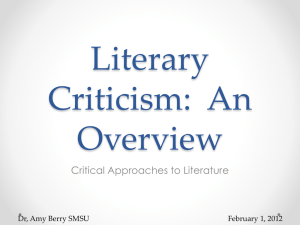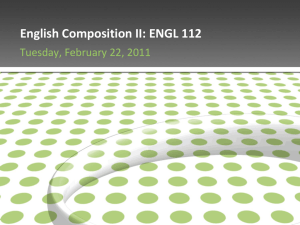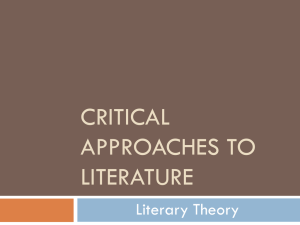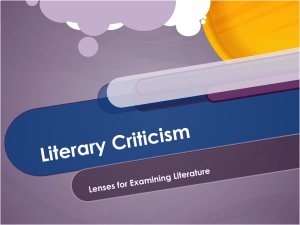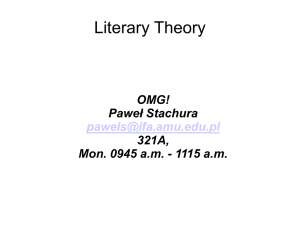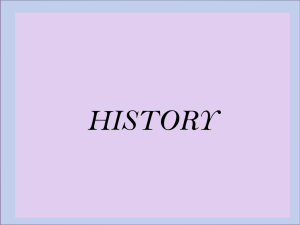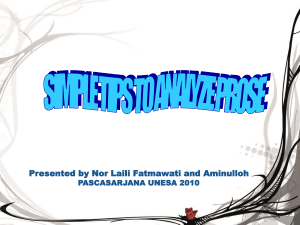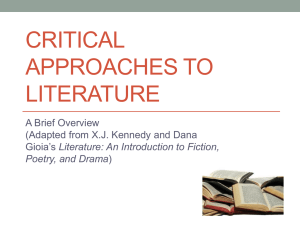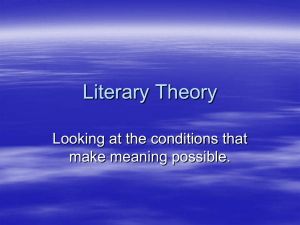Literary Criticism Theories: A Comprehensive Overview
advertisement
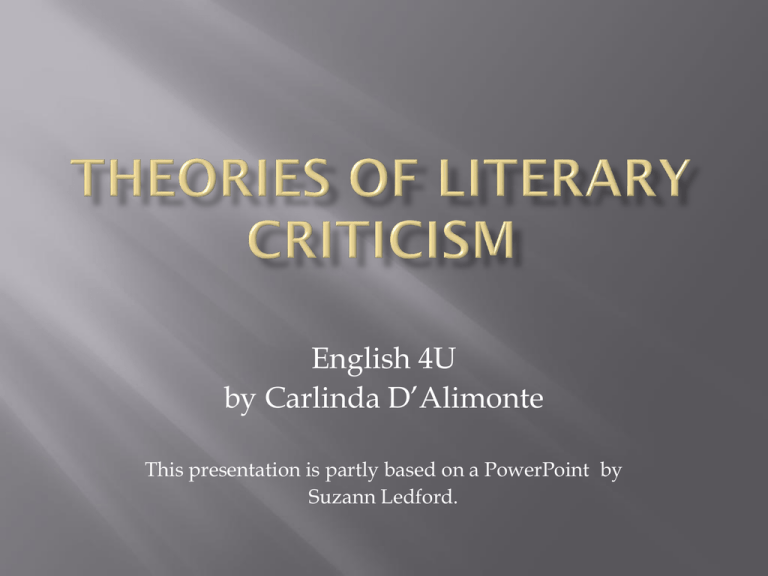
English 4U by Carlinda D’Alimonte This presentation is partly based on a PowerPoint by Suzann Ledford. Any piece of text can be read with a number of different sets of “glasses,” meaning you are looking for different things within the text. Literary Criticism helps readers understand a text in relation to the author, culture, and other texts. Literary criticism has two main functions: 1. To analyze, study, and evaluate works of literature. 2. To form general principles for the examination of works of literature. M.H. Abrams points out in The Mirror and the Lamp that “any reasonably adequate theory takes some account of . . . four elements” (6). These elements are 1. The work itself 2. The artist who creates the work 3. The universe or the nature that is being imitated by the work 4. The audience of the work The following slides discuss specific 20th century literary theories. As we discuss these, you may find yourself agreeing with one or two theories while disagreeing heartily with another. Keep in mind that no single theory offers the “right” answer about a work of literature; good literature is simply too varied. Keeping an open mind and listening to other points of view can enrich your own insights; that is the purpose of criticism. Links to Critical/Theoretical Approaches: New Criticism Archetypal/Myth Criticism Psychoanalytic Criticism Marxism Postcolonialism Existentialism Phenomenology, and Hermeneutics Russian Formalism/Prague Linguistic Circle/Linguistic Criticism/Dialogism Avant-Garde/Surrealism/Dadaism Structuralism and Semiotics Post-Structuralism and Deconstruction Postmodernism New Historicism Reception and Reader-Response Theory Feminism Genre Criticism Autobiographical Theory Travel Theory Links to Other General Literary Theory Websites General Resources - Bibliography of Critical Theory Texts Moral Criticism, Dramatic Construction (~360 BC-present) Formalism, New Criticism, Neo-Aristotelian Criticism (1930spresent) Psychoanalytic Criticism, Jungian Criticism(1930s-present) Marxist Criticism (1930s-present) Reader-Response Criticism (1960s-present) Structuralism/Semiotics (1920s-present) Post-Structuralism/Deconstruction [Post-Modernism] (1966present) New Historicism/Cultural Studies (1980s-present) Post-Colonial Criticism (1990s-present) Feminist Criticism (1960s-present) Gender/Queer Studies (1970s-present) (Brizee) Biographical/Historical Modernism/Formalism/New Criticism Psychoanalytic Archetypal/Mythological Sociological Marxist Reader-Response Structuralism New Historian/Cultural Studies Post-Modernism Feminist Analyzes an author’s life in regard to their work can enhance the understanding of a work Work is analyzed for relevance to its author Understanding the work helps us understand the author and visa versa Works are placed in their historical context to grasp meaning Research into the time period in which the piece was written enlightens understanding What events in the author’s life helped to shape the work? What beliefs and prejudices have influenced the work? How has the author’s cultural milieu influenced the work? Has the author’s age, race, religion, etc. shaped the work? Wilde had an intimate knowledge of “Bunburying” because he led a doublelife too in his homosexual relationship with a young Oxford student. The characters’ flippant attitude about marriage mirrors Wilde’s own casual devotion to his wife. Rejected traditional ways of reading literature (historical, autobiographical, etc.) Text contains meaning that can be understood apart from external factors focuses on symbol, metaphor, imagery, foreshadowing, alliteration, and so on Has the advantage of forcing writers to evaluate a work on its own terms rather than to rely on “accepted” notions of the writer’s work Works best when applied to poetry and short fiction. Attempts to discover meaning by close reading of a work of literature. Focus is on: Form, organization, and structure Word choice and language Multiple meanings Considers the work in isolation, disregarding author’s intent, author’s background, context, and anything else outside of the work itself. The formalist movement began in England with the publication of I.A. Richards’ Practical Criticism (1929). American critics (such as John Crowe Ransom, Robert Penn Warren, and Cleanth Brooks) adapted formalism and termed their adaptation “New Criticism.” New Criticism varied from formalism in that New Criticism focuses on image, symbol, and meaning. Traditional formalists often attacked New Critics for their lack of attention to the form of the work. Seminal works on New Criticism include John Crowe Ransom’s The New Criticism (1941) and Cleanth Brooks’ The Well Wrought Urn (1947). Today, few critics adhere only to the Modernist, Formalist or New Criticism theory. However, its backto-the-basics approach pervades many other critical theories. How does the work use imagery to develop its own symbols? (i.e. making a certain road stand for death by constant association) What is the quality of the work's organic unity "...the working together of all the parts to make an inseparable whole..." (Tyson 121)? In other words, does how the work is put together reflect what it is? How are the various parts of the work interconnected? How do paradox, irony, ambiguity, and tension work in the text? How do these parts and their collective whole contribute to or not contribute to the aesthetic quality of the work? How does the author resolve apparent contradictions within the work? What does the form of the work say about its content? Is there a central or focal passage that can be said to sum up the entirety of the work? How do the rhythms and/or rhyme schemes of a poem contribute to the meaning or effect of the piece? (Brizee) Analyzes literature to reveal insights about the way the human mind works. Is based on the work of Sigmund Freud and his disciples. Works well as a method of analyzing characters’ actions and motivations. All actions are influenced by the unconscious. Human beings must repress many of their desires to live peacefully with others. Repressed desires often surface in the unconscious, motivating actions. The mind has three major areas of activity: Id: Area in the unconscious that works for gratification through the pleasure principle Superego: An internal censor bringing social pressures to bear on the id. Ego: Area in the consciousness that mediates among demands of social pressure, the id, and the superego. Drives governing human behavior Id – the animal nature that says, “Do what feels good.” Ego – the reality-based part of your personality that makes decisions to satisfy the Id and Superego Superego – the socialized “conscience” that tells you what’s right or fair Macbeth kills King Duncan because he unconsciously recognizes the king as a fatherfigure. Hence, Duncan is a rival for power and the affections of the people. In the latter acts of the play, Macbeth has indulged his id so often that his ego has lost the ability to restrain it. How do the operations of repression structure or inform the work? Are there any oedipal dynamics - or any other family dynamics are work here? How can characters' behavior, narrative events, and/or images be explained in terms of psychoanalytic concepts of any kind (for example...fear or fascination with death, sexuality - which includes love and romance as well as sexual behavior - as a primary indicator of psychological identity or the operations of ego-id-superego)? What does the work suggest about the psychological being of its author? What might a given interpretation of a literary work suggest about the psychological motives of the reader? Are there prominent words in the piece that could have different or hidden meanings? Could there be a subconscious reason for the author using these "problem words"? (Brizee) Largely attributed to Carl Jung, a disciple of Sigmund Freud Archetype: a model or pattern from which all other things of a similar nature are made Collective Unconscious--there are certain basic and central images and experiences that are inherent in the human psyche Analyzes what in a work evokes a similar response in people, regardless of culture Concerned with enduring patterns and how they are reflected in literature Common Themes: Stories of quest and initiation Descents into the underworld Ascents into heaven Search for father/mother Fall from innocence Characters: Scapegoat Hero/Villian Outcast Temptress Mother/Father Mentor Beowulf is the archetypal hero because his bravery and righteous behavior embodies the ideals and hopes of AngloSaxon society. Grendel, the outsider, represents both the alien invaders of neighboring, warring tribes and the threat of supernatural monsters, which, as pagans, the AngloSaxons truly believed existed. What connections can we make between elements of the text and the archetypes? (Mask, Shadow, Anima, Animus) How do the characters in the text mirror the archetypal figures? (Great Mother or nurturing Mother, Whore, destroying Crone, Lover, Destroying Angel) How does the text mirror the archetypal narrative patterns? (Quest, Night-Sea-Journey) How symbolic is the imagery in the work? How does the protagonist reflect the hero of myth? Does the “hero” embark on a journey in either a physical or spiritual sense? Is there a journey to an underworld or land of the dead? What trials or ordeals does the protagonist face? What is the reward for overcoming them? (Brizee) Examines structure to find meaning Uses patterns or codes of interpretation “’Structuralism is used in literary theory, for example, "...if you examine the structure of a large number of short stories to discover the underlying principles that govern their composition...principles of narrative progression...or of characterization...you are also engaged in structuralist activity if you describe the structure of a single literary work to discover how its composition demonstrates the underlying principles of a given structural system’ (Tyson 197198)” (Brizee). What patterns exist within the text that connect it to the larger "human" experience? In other words, can we connect patterns and elements within the text to other texts from other cultures to map similarities that tell us more about the common human experience? This is a liberal humanist move that assumes that since we are all human, we all share basic human commonalities. What rules or codes of interpretation must be internalized in order to 'make sense' of the text? (Brizee) Sees the reader as essential to the interpretation of a work. Each reader is unique, with different educations, experiences, moral values, opinions, tastes, etc. Therefore, each reader’s interaction with a work is unique. Analyzes the features of the text that shape and guide a reader’s reading. Emphasizes recursive reading— rereading for new interpretations. Reader-response theory has been criticized as being overly impressionistic and guilty of the affective fallacy (too focused on the emotional effect of the work). Less tactful critics have plainly said that it is not intellectual. These attacks resulted in an adaptation of reader-response criticism called reception theory. How does the interaction of text and reader create meaning? What does a phrase-by-phrase analysis of a short literary text, or a key portion of a longer text, tell us about the reading experience prestructured by (built into) that text? Do the sounds/shapes of the words as they appear on the page or how they are spoken by the reader enhance or change the meaning of the word/work? How might we interpret a literary text to show that the reader's response is, or is analogous to, the topic of the story? What does the body of criticism published about a literary text suggest about the critics who interpreted that text and/or about the reading experience produced by that text? (Tyson 191) (Brizee) Maintains that the literary work cannot be separated from the social context in which it was created. In general, sociological criticism examines one of these two aspects: Conditions of production, such as schools, magazines, publishers, and fashions. The applicability of a given work— fiction especially—in studying the dynamics of a given society. Sociological theory is so broad that it can be subdivided in many different categories. Two dominant theories we’ll study are Marxist criticism Feminist criticism Marxist criticism is based on the social and economic theories of Karl Marx and Friedrich Engels. Their beliefs include the following: Value is based on labor. The working class will eventually overthrow the capitalist middle class. In the meantime, the middle class exploits the working class. Most institutions—religious, legal, educational, and governmental—are corrupted by middle-class capitalists. Marxist critics apply these economic and social theories to literature by analyzing: Ideologies that support the elite and place the working class at a disadvantage Class conflict Marxism strongly influenced fiction, particularly American fiction, in the 1930s. Whom does it benefit if the work or effort is accepted/successful/believed, etc.? What is the social class of the author? Which class does the work claim to represent? What values does it reinforce? What values does it subvert? What conflict can be seen between the values the work champions and those it portrays? What social classes do the characters represent? How do characters from different classes interact or conflict? (Brizee) Feminist criticism grew out of the women’s movement that followed World War II. Feminist critics analyze the role of gender in works of literature. Leading critic Elaine Showalter describes two purposes of feminist criticism: Feminist critique: The analysis of works by male authors, especially in the depiction of women’s writing Gynocriticism: The study of women’s writing Feminist critics have been responsible for recovering neglected works by women authors through the ages and creating a canon of women’s writing. A case in point is Kate Chopin. She was fairly widely published in the 1890s, but her work was largely neglected by literary critics until the 1960s, when Chopin was “rediscovered” by feminist critics. How is the relationship between men and women portrayed? What are the power relationships between men and women (or characters assuming male/female roles)? How are male and female roles defined? What constitutes masculinity and femininity? How do characters embody these traits? Do characters take on traits from opposite genders? How so? How does this change others’ reactions to them? What does the work reveal about the operations (economically, politically, socially, or psychologically) of patriarchy? What does the work imply about the possibilities of sisterhood as a mode of resisting patriarchy? What does the history of the work's reception by the public and by the critics tell us about the operation of patriarchy? (Brizee) Reception theory is applied to the general reading public rather than an individual reader. Each generation has different experiences, values, issues, etc. Therefore, each generation will read a work differently. New historicist critics view literature as part of history, and furthermore, as an expression of forces on history. New historicism compares literary analysis to a dynamic circle: The work tells us something about the surrounding ideology (slavery, rights of women, etc.) Study of the ideology tells us something about the work. New historicism takes two forms: Analysis of the work in the context in which it was created Analysis of the work in the context in which it was critically evaluated. New historicists assert that literature “does not exist outside time and place and cannot be interpreted without reference to the era in which it was written” (Kirszner and Mandell 2038). Readers are influenced by their culture, so no objective reading of a work is possible. Critics should consider how their own culture affects their interpretation of the historical influence on a work. What language/characters/events present in the work reflect the current events of the author’s day? Are there words in the text that have changed their meaning from the time of the writing? How are such events interpreted and presented? How are events' interpretation and presentation a product of the culture of the author? Does the work's presentation support or condemn the event? Can it be seen to do both? How does this portrayal criticize the leading political figures or movements of the day? How does the literary text function as part of a continuum with other historical/cultural texts from the same period...? How can we use a literary work to "map" the interplay of both traditional and subversive discourses circulating in the culture in which that work emerged and/or the cultures in which the work has been interpreted? How does the work consider traditionally marginalized populations? (Brizee) In its simplest terms, postmodernism consists of the period following high modernism and includes the many theories that date from that time, e.g., structuralism, semiotics, poststructuralism, deconstruction, and so forth . . . postmodernism marks a culture composed "of disparate fragmentary experiences and images that constantly bombard the individual in music, video, television, advertising and other forms of electronic media. The speed and ease of reproduction of these images mean that they exist only as image, devoid of depth, coherence, or originality" (Childers and Hentzi 235). “Postmodernism, in contrast [to Modernism}, doesn't lament the idea of fragmentation, provisionality, or incoherence, but rather celebrates that. The world is meaningless? Let's not pretend that art can make meaning then, let's just play with nonsense” Klages) How does the work undermine or contradict generally accepted truths? How does the author (or a character) omit, change, or reconstruct memory and identity? How does a work fulfill or move outside the established conventions of its genre? How does the work deal with the separation (or lack thereof) between writer, work, and reader? What ideology does the text seem to promote? What is left out of the text that if included might undermine the goal of the work? If we changed the point of view of the text - say from one character to another, or multiple characters - how would the story change? Whose story is not told in the text? Who is left out and why might the author have omitted this character's tale? (Brizee) Abrams, M.H. The Mirror and the Lamp. London: Oxford UP, 1953. Print. Aljohani, Aouda, and Thamer Al-Ghamdi. Literary Criticism Map. 2003. Web. 2 Sept. 2010. <http://wwww.ksu.edu.sa/colleges/art/eng/461Eng/Literary%20Criticism%20Map.htm>. Arnold, Matthew. “The Function of Criticism at the Present Time.” Selected Prose. Ed. P.J. Keating. London: Penguin, 1970. 130-157. Print. Brizee, Allan, and J. Cole Tompkins. "Literary Thoery and Schools of Criticism." OWL Purdue Online Writing Lab. Purdue University, April 20, 2010. Web. 31 Aug 2010. <http://owl.english.purdue.edu/owl/resource/722/01/>. Childers and Hentzi, The Columbia Dictionary of Literary and Cultural Theory. Columbia University Press, May 1995. Print. Holman, C. Hugh and William Harmon. A Handbook to Literature. 6th ed. New York: Macmillan, 1992. Print. Klages, Mary. Literary Theory: A Guide for the Perplexed. Contunuum Press, January 2007. Web. 31 Auguast 2010. <http://www.colorado.edu/English/courses/ENGL2012Klages/pomo.h tml>. Keating, P.J. Introduction. Selected Prose. By Matthew Arnold. Ed. Keating. London: Penguin, 1970. 9-36. Print. Kirszner, Laurie G. and Stephen R. Mandell. Literature: Reading, Reacting, Writing. 3rd ed. Fort Worth: Harcourt Brace, 1997. Print. Pope, Alexander. An Essay on Criticism. The Norton Anthology of English Literature. 7th Major Authors ed. Ed. M.H. Abrams and Stephen Greenblatt. New York: Norton, 2001. 1123-1134. Print.
